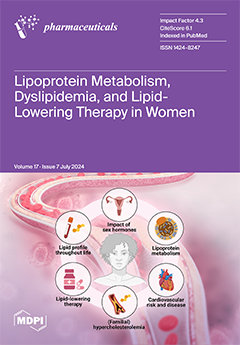Oxidative stress impairs the structure and function of the cell, leading to serious chronic diseases. Antioxidant-based therapeutic and nutritional interventions are usually employed for combating oxidative stress-related disorders, including apoptosis. Here, we investigated the hepatoprotective effect of oligosaccharides, produced through
Pichia pastoris-mediated
[...] Read more.
Oxidative stress impairs the structure and function of the cell, leading to serious chronic diseases. Antioxidant-based therapeutic and nutritional interventions are usually employed for combating oxidative stress-related disorders, including apoptosis. Here, we investigated the hepatoprotective effect of oligosaccharides, produced through
Pichia pastoris-mediated fermentation of water-soluble polysaccharides isolated from
Lepidium sativum (cress) seed mucilage, on chromium(VI)-induced oxidative stress and apoptosis in mice. Gel permeation chromatography (GPC), using Bio-Gel P-10 column, of the oligosaccharides product of fermentation revealed that
P. pastoris effectively fermented polysaccharides as no long chain polysaccharides were observed. At 200 µg/mL, fractions DF73, DF53, DF72, and DF62 exhibited DPPH radical scavenging activity of 92.22 ± 2.69%, 90.35 ± 0.43%, 88.83 ± 3.36%, and 88.83 ± 3.36%, respectively. The antioxidant potential of the fermentation product was further confirmed through in vitro H
2O
2 radical scavenging assay. Among the screened samples, the highest H
2O
2 radical scavenging activity was displayed by DF73, which stabilized the free radicals by 88.83 ± 0.38%, followed by DF53 (86.48 ± 0.83%), DF62 (85.21 ± 6.66%), DF72 (79.9 4± 1.21%), and EPP (77.76 ± 0.53%). The oligosaccharide treatment significantly alleviated chromium-induced liver damage, as evident from the increase in weight gain, improved liver functions, and reduced histopathological alterations in the albino mice. A distinctly increased level of lipid peroxide (LPO) free radicals along with the endogenous hepatic enzymes were evident in chromium induced hepatotoxicity in mice. However, oligosaccharides treatment mitigated these effects by reducing the LPO production and increasing ALT, ALP, and AST levels, probably due to relieving the oxidative stress. DNA fragmentation assays illustrated that Cr(VI) exposure induced massive apoptosis in liver by damaging the DNA which was then remediated by oligosaccharides supplementation. Histopathological observations confirmed that the oligosaccharide treatment reverses the architectural changes in liver induced by chromium. These results suggest that oligosaccharides obtained from cress seed mucilage polysaccharides through
P. pastoris fermentation ameliorate the oxidative stress and apoptosis and act as hepatoprotective agent against chromium-induced liver injury.
Full article






